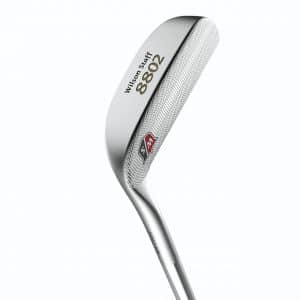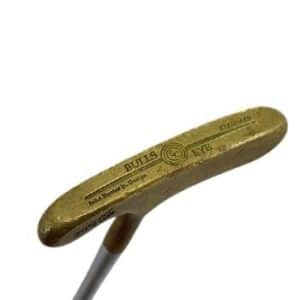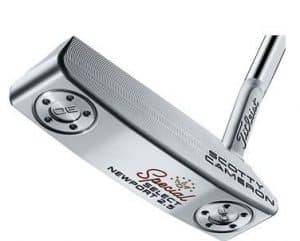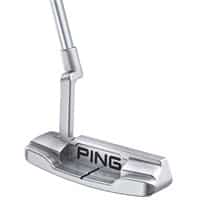“Golf is a good walk spoiled”, famously attributed to Mark Twain, but apparently penned by writer Henry Leon Wilson in a novel back in 1905.
Whoever it was, nothing can spoil a good game of golf more than not getting it in the hole. Three puts, and leaving it way short can be one of the most frustrating parts of the great game of golf. Having one of the best putters of all time will make all the difference.
It is surprising how little attention is paid to this very important club by the average golfer. It seems to be an attitude of, “well I need a putter, this one looks good, I’ll take it”.
It is equally interesting to see just how much technology has been developed around the putter in the last 10 or 20 years.
At a glance: Our Top 5 Picks for Best Putters Of All Time
Early Putters
The first putters were typically made with a stick, or shaft, usually of Ash, and a head fashioned out of Birch, and was known as a “cleek”. Only in the mid 19th century, after the “feathery” ball was replaced by the “gutta-percha” ball did metal heads make an appearance.
Players like Bobby Locke and Bobby Jones played with hickory shafted putters with metal heads, commonly called “flatsticks”. Jones’s putter, which saw him win 13 majors, was known as “Calamity Jane”.
Putter Development
The next great leap in putter history came after WW2 when Ping came up with the ANSER, so named as it was to be the ‘answer’ to putting problems. Forged from manganese bronze the Anser was beautiful and very effective.
The Gary Players’ and Tony Jacklins’ of the day scrambling to get hold of them. They were a favorite of all the top pros and were used by Tiger Woods as a junior. The basic design of the heel fitted shaft was still the norm.
Then along came Scotty Cameron to help Bernard Langer win the 1993 Masters. He refined the basic Anser design by adding a soft trailing edge, a custom face milling, and a whole bunch of other modifications.
The putter revolution had begun, and we now have a staggering variety of styles, colors, and metals, alloys, and synthetic materials used to boggle the mind and complicate decision making.
As is the modern trend, every sporting brand has a research and development department, each trying through hi-tech to outdo each other. Along with this tech explosion comes a whole new vocabulary and terminology that we need to learn and understand.
Finding The Best Putter of All Time For You
Before looking at the different characteristics of putters, it is important to look at yourself, your height, build, and individual style and preferences. One of the most important style aspects is your stroke arc.
Do you have a straight-back-straight-through putting stroke, or do you have an arc? Some players arc from the inside, others from out to in, and there are simple ways to test and determine your putting arc style.
The next thing you need to find is your “lie”. If your putts are consistently inconsistent, such as your distance control is offline or inaccurate, or you regularly strike the wrong part of the clubface, your putter may have the wrong lie angle. The lie angle is mostly affected by the length, longer putters have flatter angles.
A good test is to spray the face of the putter with some foot powder, hit a dozen puts, and check the strike pattern. If the puts are tightly grouped in the center of the face, you have the right lie.
If tightly grouped off-center, you need a different lie. If they are all over the place the problem could be length, weight, balance or you just need more practice.
This brings us to putter length, the standard putter is 34 inches. This is ideal for a male of 5’10’’, bending at 40 degrees over the ball with his hands 32 inches above the ground. Standing too close to the ball, or not being able to get your eyes over the ball, your length is too short, or too long.
The loft of the putter, that is the angle between a level surface and the face of the club, is another important feature to get right. The standard loft is 2-4 degrees but can change with the ball and your stance at address. The loft provides lift and impact and is more important on slower greens.
Factors still to consider is the type of grip, there are more than half a dozen varieties, and putter head weight. The most common weight is 350 grams. Lighter weights are suitable on faster greens while a slightly heavier weight might be preferred on slow greens.
Golf Putters Have The Following Characteristics:
Putter head shapes come in one of three styles. First is the original blade, with its’ slender classic design, best suited for the straight-back-straight-through stroke.
Peripheral weighted putters, such as the Ping Anser, with a larger sweet spot offering more forgiveness for a straight or arc stroke. Lastly, mallet putters, with their distinctive deep heads and a lower center of gravity. These clubs suit the curved stroke and are highly forgiving if you miss the sweet spot.
The balance of the putter head will also influence your choice, with face-balanced putters favoring the straight stroke. Toe-hang putters are designed to minimize the twisting motion through your arc stroke.
There are further features that are more a matter of personal taste, style, and feel. The hosel, where the shaft joins the head, comes in various styles. They can be offset, double bend, short, plumber’s neck, or onset, each designed for a specific outcome or condition.
Heel-shafted and center-shafted putters don’t have a hosel as the shaft connects directly to the head.
A measure of a putter’s forgiveness is its’ MOI, or moment of inertia. Putters with larger heads and faces reduce twisting and error from shots missing the sweet spot.
Finally, the putter head design will feature some kind of milling, grooves, or inserts that affect the contact with the ball. These variables will influence the feel, sound, forgiveness, roll, and spin. That being said, it is largely a matter of taste, as are the Fang, Spider and other unusual designs mostly found on mallet heads.
Quick Overview: Our Top Picks for Best Putters Of All Time
| IMAGE | PRODUCT | DETAILS | |
|---|---|---|---|
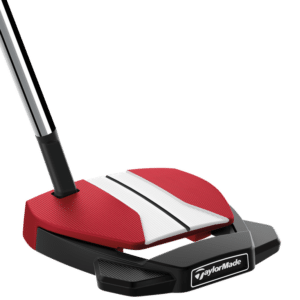
|
TaylorMade TP Red |
|
CHECK LATEST PRICE → |
| OUR RATING: 4.8/5 |
Odyssey Toe Up Ladies Putter |
|
VIEW ON AMAZON → |
| OUR RATING: 4.8/5 |
Odyssey White Hot Pro 2 |
|
VIEW ON AMAZON → |
 |
Wilson 8802 |
|
CHECK LATEST PRICE → |
 |
Titleist Bullsey |
|
CHECK LATEST PRICE → |
Reviews of The Best Putters of All Time
It’s time to take a closer look at some of the best golf putters of all time.
1. TaylorMade TP Red
Pros:
- Aesthetically pleasing milled 304 stainless steel heads
- Adjustable sole weights enable you to find the ideal head weight
- Adjustable sole weights
- All strokes catered for with an array of designs, toe hangs, and hosels across the range
- Pure Roll insert enhances the feel
Cons:
- Head may be too small for high handicap golfers
TaylorMade may be the name that you associate with top quality irons, wood, and drivers, but are lesser known for their excellence in putters.
This changed with the Spider Tour Collection which initiated a wide range of red putters from a variety of manufacturers. TaylorMade released the TP Red Collection in the same year as the Spider Tour Collection.
Looking purely at feel, along with consistency and quality of roll, you cannot help but be hugely impressed with this collection of putters.
There are loads of innovative technology in the TP Red Collection such as the 6061 Aluminum Pure Roll insert with soft polymer between the 45° grooves and a that promote the optimal forward roll-firm feel.
The fang shape split the weight, raise stability, and improve off-center forgiveness.
If you prefer to mark a line on your ball and accurately line your ball up, the TP Red Collection has a white sightline on the top rail assisting you in your alignment and indicates exactly where the center of the ball should be when contact is made.
Expensive? Yes. Worth the investment? Absolutely!!
Here’s one for the ladies. Do you often find it difficult to keep the face square, and starting the ball rolling on line? Innovative design technology from Odyssey has addressed this problem and introduced features in the Toe Up, proven to reduce this error.
The Toe Up has been designed with the emphasis on making it easier to control the head through the stroke. The first design feature that greatly influences the performance of this putter is the Stroke Balanced Technology.
Most modern putters tend to move the center of gravity back from the club face through perimeter weighting. With the Odyssey Toe Up the center of gravity is placed directly behind the face, reducing torque through impact and presenting the face square to the ball and the line.
This setup ensures that the hands stay ahead of the center of gravity at all times. Unlike other putters, this Odyssey has a face that balances “toe up”.
Another modification is the positioning of the hosel, placing the shaft axis directly over the center of gravity. This not only provides stability but further reduces torque during the stroke.
Because the center of gravity in the Odyssey Toe Up sits so far forward, the face of the putter does not have an insert. The face is instead milled with a chemically etched oval pattern that increases friction to set the ball off quickly and on line.
With the updated white hot insert this new Odyssey demonstrates a huge improvement in both feel and sound. The White Hot Pro 2 has a plumber’s neck offset shaft, and heel-toe balanced weighting, useful for alignment and forgiveness.
The dashes on the bottom of the putter are for Odyssey’s innovative Eye-fit system and help you to work out your best eye position at address. The comfortable grip comes with clear markings, and there is a Jumbo grip option.
This putter comes in the classic blade design with a very attractive, glare-free Gun Metal finish.
In 2014 Wilson reached its century in the sports equipment industry and to celebrate the occasion they released an updated version of the Wilson Staff 8802 putter that was first released in 1963. The initial release on 1 November 1963 came after Arnold Palmer left Wilson Staff and the company renamed the Designed By Palmer putter to the Wilson 8802.
The basic design remains untouched, and Wilson Staff added a little weight bringing the putter to 335 grams and added a double milled face. This retains the classic looks and history that goes with the 8802 putter but the double milling produces a softer feel off the face and a less clicky sound.
It takes you back in time to when great putters used the 880 with its silky looks and great feel.
It is a design preferred by some of the best players in history, the 8802 is sleek, feels great, and is a ton of fun to putt with.
The lack of alignment aids should not be a problem for golfers that use the Wilson 8802 as it is aimed at great putters. This is not a putter for golfers that are looking to improve their game requiring a high MOI, is counterbalanced and adjustable.
The sole deviates slightly from the original with a glossy, mirror-like finish while the rest of the 8802 has a duller, matte finish to help you escape from reflections and glare.
Golfers with a straight-back-straight-through stroke will feel lost as the toe is eager to open on the back stroke and close on the forward stroke.
Making it easier to grip, Wilson Staff added a Lamkin 3GEN grip to make it feel comfortable in your hands.
Although it deviates slightly from the original great putters will appreciate the look, feel, and quality of the Wilson 8802 for many years to come
In a similar vein to the Wilson 8802, the Titleist Bullseye is a classic putter that comes with a history of winning major tournaments.
Titleist’s Bullseye was introduced in the mid-1940s and quickly became a favorite amongst professional and amateur golfers alike.
Its uncomplicated design produces a brass head that could be used by left-handed and right-handed golfers, a pure blade with no flanges or wings offering a soft feel. Included in the design was the innovative center-shafted design that evenly distributes its weight both between the shaft to the toe of the putter and the shaft to the heel of the putter. This aids in a balanced roll on off-center strikes.
Scotty Cameron, an icon in putter design, revived the Titleist Bullseye design recent by introducing a milled face on a carbon-steel clubhead that is almost certain to remain a classic for many years in the future.
The design meant the weight would more easily balance off-center hits. The club was offered in both a straight and flanged model. The softer brass clubhead offered players a new feel in their putting game.
Here, we have a club suited for beginners and the budget-conscious. The Pinemeadow Men’s PGX is priced below $ 40, but don’t let that make you believe that it can’t deliver.
This mallet designed putter is weighted to deliver a smooth spin on the ball and a reduced skid. It has a clean white color with prominent alignment features promoting easy setup.
The Pinemeadow Men’s PGX receives a high rating, and good reviews from golf critics, and delivers a consistent, confidence building result.
Research conducted on putts within 12 feet of the hole found that 66% of putts are struck towards the toe of the putter
This finding led TaylorMade engineers to design the SpiderX to change the mass profile of the putter while introducing True Path technology.
These changes improve the alignment of the ball and the putter face leading to more center strikes.
The carbon fiber insert in the central area of the sole offered the chance to move the weight saved to the outer perimeters and led to a reduction of 5% on the size of the SpiderX head.
The perimeter weighting stabilized the head 36% and created a 37mm deeper center of gravity. The design changes retained the MOI characteristics of the Spider putter.
In addition to the SpiderX’ s composite core weighing of 15g, seamless additional dedicated weight design features are enabling the addition of 2 weights (aluminum 2g, steel 6g).
2g tungsten weights are available as an optional extra, allowing for optimizing your weight preferences.
The 33-inch shaft will find the most benefit from the use of the 2g aluminum weights while the 34- and 35-inch shafts will benefit more from the 6g steel weights.
Optically engineering on the Spider X features created a vision system designed to improve the path, vision, and visual perception through color sensitivity.
A larger surlyn insert increased by 2mm to 5mm and consists of a combination of 80% surlyn and 20% aluminum flakes.
The 12 grooves set at a 45° angle in the insert aids in better distance control a smoother roll and greater accuracy. Sound and feel are greatly enhanced by the new surlyn insert.
Not everyone will find the Navy-Blue color scheme to their liking, but the benefits far outweigh the concerns.
8. Titleist Scotty Cameron Special Select Newport 2,5 Putter
Pros:
- Solid 303 stainless steel for legendary performance and playability
- The select series is tour proved and the flagship model
- Stability through the strike
- Aesthetically pleasing at address
- Performance balanced weighting
Cons:
- Price tag
- Blade type not for all. (other shapes available)
Scotty Cameron putters are used by some of the best putters on the tour.
Jordan Spieth, Brooks Koepka, Tiger Woods, and Sergio Garcia to name a few.
Hideki Matsuyama used his Newport Model to win the 2021 Masters on some of the trickiest greens ever.
Titleist has incorporated various shapes in the Special Select range to suit the golfer’s personal preference.
The solid 303 stainless steel milled head produces a consistent sound and soft feel.
A soft Tri-sole design promotes a proper setup at address, while providing a stable, aesthetically pleasing view of the topline.
Scotty’s signature three-dot pattern on the back cavity is milled then each dot hand-painted with Cheery Red translucent paint.
Performance balanced weighting is spread towards the heel and toe, creating a larger sweet spot and enhanced stability.
The raw stainless steel finish provides a radiant yet glare-resistant appearance.
A 34-inch putterflex steel shaft with a standard grip and headcover looks professional.
An ideal replacement for your Titleist Scotty Cameron Select 2018 putter is the Odyssey White Hot OG. Odyssey has long been at the forefront of putter innovation and has not slowed down with this product.
The putter is ideal for superior putters who are looking for a smooth feel and crisp acoustics at impact. The White Hot OG provides a consistent level of topspin to deliver consistent roll while offering an optimal level of forgiveness even on off-center strokes.
While the White Hot OG does offer a high level of forgiveness. The blade head may not provide higher handicappers with the control they enjoy from mallet head putters. Check the best putters for high handicaps.
Furthermore, the putter is available in a standard and jumbo grip size to cater to a broader audience of golfers.
Finally, the White Hot OG contains a topline putting alignment aid to help you line up and start your putt on the right line. Ultimately leading to fewer putts per round and lower scores.
If you feel that the time has come to replace your Titleist Scotty Cameron Select 2018 putter, you can find out more about the Odyssey White Hot OG here.
10. Ping Anser
Pros:
- Great distance control
- Good feel
- Options in terms of weight and inserts
- Classic blade look
Cons:
- Weigh choice is crucial
- Not much visual technology (if that’s what you’re looking for)
Karsten Solheim designed a new putter in January of 1966, this putter had an offset hosel, a cavity back, low center of gravity and lines to help square the face. This putter was to be the answer to the problem, the problem was putting. Karsten’s wife gave the club its name, suggesting leaving out the W.
In 2016 the Ping Anser celebrated it’s 50th anniversary, with an unbeatable record of over 500 tour wins, including 19 majors. Further bragging rights belong to Anser as the most copied design and Solheim’s innovations are still found in most putter designs today.
Originally constructed out of brass which was much too soft, the high-strength manganese bronze version took over. In the mid-1970s more than half of the tour pros were using a Ping Anser on the greens, an incredibly high standard.
The Cadence TR Anser 2 is one of the latest models and features two versions, a heavy black, and a lighter blue insert model. The graduated grooves on the face seem to enlarge the sweet spot and greatly assists the roll of the ball and the distance control. The feel on both models is great with the blue soft insert tending to hold the ball just a fraction. The balance and forgiveness are top class even on off-center shots.
Final Thoughts
Golf has come a long way since the days when King Henry IV had his crude sticks made for him in the 1500s. Putters have not been left behind in the technology revolution, and the flatstick now belongs in the museum.
If you consider that the average golf course has a par rating of 72, with a mix of par 3, 4, and 5 holes, it allows for two putts per hole. That means a perfect par round would require 36 putts or exactly half of your score.
With that in mind, it might be a good idea to spend a bit more time finding the right putter.
Related Articles
- The 7 Best Blade Putters
- The Best Putters For Cheap
- 7 of The Best Mallet Putters
- 5 of The Best Putters This Year
- How to Measure a Putter Length the Correct Way
- Best PING Golf Putters 2022
Nick is the founder of GolfSpan and an avid golfer. He's not quite a pro but has over 15 years of experience playing and coaching golfers worldwide. His mission is to bring the golfing community a better experience when it comes to choosing the right golf gear and finding the right setup for your game.
